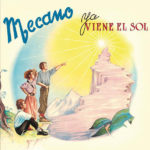
What a shining moment. It took Mecano two albums to properly shake off being also-rans, to truly get to what made (or would make) them special. Mecano’s Ya Viene El Sol is an electro-pop album but it’s also one slippery enough to fit many other styles and genres, yet still come off as theirs. Outside of the English-speaking world Mecano has legions of fans, negating the need to ever break in our shores, guarding their secrets very well for Spanish-speakers — to our loss. In Latin America, since we already know them as a huge deal, we tend to obscure their earlier, more experimental, less defined work. Somewhere in between, all of this, lay gems like, Ya Viene El Sol, in their discography which can unite all their vision in a way anyone can understand.
Mecano began, in Madrid, as a duo led by brothers Nacho and José María Cano. José María Cano fashioned himself a singer-songwriter but had very little courage or impetus to want to take the role as singer. Nacho, the younger of the two, had been practicing with a friend, Ana Torroja, as a duo on a different project altogether. As they realized they couldn’t possibly perform live as a sibling group, pushed the timid Ana Torroja into the focus as the lead singer of their band. Abandoning their art school studies, as a trio, they gave it a go as synthpop group.
Revolutionizing and popularizing the Madrid art movement (Movida Madrileña), Mecano released singles and had a certain look that was just plain different from the rest of the scene. Singles like “Hoy No Me Puedo Levantar”, although hits, largely left them on an island, on the roster of huge labels like CBS, letting them create their own style, sound, and process, with little input (and money) from the label. Originally thought of as a novelty group, Mecano had released songs like “Quiero Vivir En La Ciudad” which owned the new Spanish identity other homegrown groups had run away from, when turning to the Pop world. It was those turns inward that quickly endeared them as a “national” band.
By the time of 1983’s ¿Dónde Está El País De Las Hadas?, Mecano had decidedly far more pressure to create something. By now, they were a hit group with legions of fans copying their style and countless others sending their debut and follow-up album into multi-platinum strata. Being one of the first groups to absorb and promote music videos, to control their own image, to create their own music, was constantly pushing this idea of them being labelled as sellouts, by less successful Spanish groups. Things had come to a head by the end of 1983. For Nacho, he sought refuge from the responsibility by striking out and producing other groups, where his name wouldn’t be immediately apparent. Mecano, itself, after huge tours and junkets was in need of something to rebuild from. They were tired of casting their fate, in the visions of others.
Sensing a shift that he could foment, Nacho worked with the music group Betty Troupe, notably, and with others quietly, to fashion a new sound others would dub “Movida Valenciana”. Using a new tool at his disposal (the Fairlight CMI A sampler) Nacho would create music that deliberately sounded Mediterranean, was far more danceable, and moved into tropical worlds. Emboldened by the production knowledge he learned in this other stint, Nacho brought these same ideas to what would become Mecano’s most experimental album to date.
For 1984’s Ya Viene El Sol, Nacho and José María came in with a clean slate with a newborn sophistication in sound, in mind. Nixing the session musicians and the producers hoisted on them from the past, they’d use the Fairlight CMI sampler to create nearly every sound and arrange every note you’ll hear on this album. Moving away from more juvenile song matters, Ya Viene El Sol would find Mecano tackling themes of hyper-industrialization, nuclear proliferation, and other far headier topics. Opening with a song called “No Pintamos Nada” (We Don’t Color Anything) showed the change, the music went even further.
“Japan” its first single, somehow, took the short-lived fascination with “asian” culture as a way to dive deep into the Kraftwerk-ian themes of man’s role against stifling conformity. The music itself perfectly capturing YMO’s own techno-world where such exploration is both subversive and quite futuristic. “Aire” the moody, free-form, floating art ballad originally was vetoed as lead single, even if its dark, Tropical sustain suited to put you that much clearer in to what you’d expect to hear. With more time in the studio, to actually treat the studio as instrument, Mecano benefited from Ana Torroja’s breathtaking vocal overdubs and treatments she’d add to all these arrangements.
Ya Viene El Sol, the album and its titular track, still remain immensely vital because of the golden bit of democratization found on this album. Dreamier Tropical Pop songs, that came quite easily to José María, were now not relegated to B-sides but held special place in the album itself. Songs like “Hawaii-Bombay”, rightfully are deep cuts and fan favorites for this reason. Nacho himself, would take cues from the minimalism of his older brother and craft gorgeous, sophisticated New Wave gems that gave and took, just as much, throughout the album. For once, beyond their image, this was music that they could stand behind as sounding definitively Mecano.
Although, it may have sold poorly — perhaps their lowest selling release ever — this is the one I keep coming back to, and one I know definitely would loosen them up to enjoy the “rightfully” earned, worldwide Pop fame they came to with 1986’s (not as experimental, but still quite good) Entre El Cielo y El Sol.
